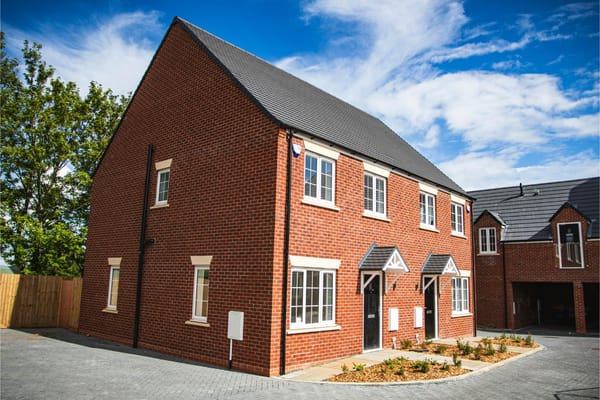Why Labour is Failing to Build the Homes Britain Needs

Few challenges loom larger over the UK’s economic and social future than the housing crisis. For decades, politicians have promised bold new housebuilding targets, yet delivery rarely matches ambition. Now, with Labour in power and its pledge to build 300,000 new homes each year, the gap between targets and reality is once again in the spotlight.
Behind the headlines, structural problems within planning, local government capacity, investor confidence, and land supply continue to hold back delivery. While policy signals are encouraging for developers and communities that desperately need more homes, many in the industry argue that these efforts still fall short of what is needed to fix the UK’s chronic housing shortage.
The Numbers: A Familiar Shortfall
Labour’s headline commitment to deliver 300,000 new homes per year would, on paper, reverse the UK’s structural undersupply that has built up over decades. Yet recent data shows that the country is nowhere near this level of delivery. According to the latest figures, annual net additional dwellings hover just above 230,000. Some local authorities have seen starts stall or even decline due to uncertainty over planning reforms, the impact of inflation on construction costs, and ongoing labour shortages.
This means that, even with optimistic assumptions, the UK faces a shortfall of nearly 70,000 homes a year. Over a five-year parliament, that equates to around 350,000 missing homes, deepening the affordability crisis that has put both buyers and renters under severe pressure.
Planning System Bottlenecks
A big part of the problem lies in the planning system, which many describe as clunky, under-resourced, and too slow to respond to local housing needs. In principle, local authorities are responsible for approving housing applications in line with their local plans. In practice, however, underfunded planning teams face backlogs, legal challenges, and political pushback from residents opposed to new development.
Labour has pledged to tackle these challenges with a wave of planning reforms, including reviving housing targets and encouraging urban brownfield development. Yet turning promises into reality takes time, and there is widespread scepticism over whether the system can adapt quickly enough to unlock the scale of housing required.
The number of major applications approved is only part of the story. Many developers hold large land banks that remain undeveloped because of viability concerns, delays in discharge of conditions, or local opposition. Without greater certainty and speed, the pipeline will remain constrained.
Green Belt Dilemmas
One of the most politically sensitive barriers to faster housebuilding is the Green Belt. Labour has indicated a willingness to review Green Belt boundaries where it makes sense to do so, focusing on releasing poor-quality or underused land near transport hubs. Yet the term “Green Belt” remains emotive, and any government that tries to reform it faces fierce local and national resistance.
Research shows that just a small fraction of the Green Belt could deliver hundreds of thousands of new homes, particularly around London and other fast-growing cities. Still, successive governments have shied away from pushing through large-scale reclassification of protected land. Without addressing this core issue, the scope for truly transformative housing growth will remain limited.
Land Supply and Developer Incentives
Beyond planning, the way land is assembled and released for development also plays a crucial role. Larger developers, who dominate new housing supply, operate on business models that often favour drip-feeding completions to maintain profit margins and avoid local market saturation.
While this approach is rational for shareholders, it runs counter to the need for rapid delivery. Critics argue that more needs to be done to diversify the development sector, supporting small and medium-sized builders who can deliver infill and smaller sites more quickly. Government pilot schemes have tried to address this, but with mixed success.
Labour has pledged to boost SME housebuilders, modernise construction methods, and invest in skills. But the incentives and capacity on the ground will take years to rebuild, and without major funding and certainty, the dominance of large players is unlikely to change soon.
Investor and Lender Confidence
Financing is another hurdle that risks holding back housing delivery. While demand remains strong, tighter mortgage affordability and high interest rates have dampened buying appetite in some areas. Developers rely on stable buyer demand to justify starting new schemes. Volatile conditions, particularly in the build-to-sell market, can cause projects to stall.
For the build-to-rent sector, which has become a significant source of new housing in urban areas, recent policy signals on rent controls and landlord regulation add another layer of uncertainty. Investors want clarity on returns and stable tax regimes before committing billions in fresh funding.
If Labour is serious about delivering on its targets, it will need to reassure institutional investors, pension funds, and lenders that the long-term environment for housing investment is stable and predictable.
The Affordable Housing Challenge
A significant proportion of the 300,000 homes Labour promises each year are meant to be affordable homes — social rent, shared ownership, or other tenure types that meet the needs of lower-income households. This is critical in cities where average private rents are now above £1,300 per month and many families spend over a third of their income on housing.
Yet funding for social housing remains patchy. Many councils and housing associations struggle to make schemes stack up without significant government grants or innovative finance. Inflation has also eroded the value of existing support packages, squeezing margins and making viability assessments more challenging.
Without a clear, well-funded plan for how these affordable homes will be delivered, it is unlikely that this segment will close the gap on its own.
Local Politics and Community Buy-In
Communities must be on board for new development to succeed. However, the perception persists that new homes often do not benefit local residents or match the types of homes people actually need.
Many residents fear that new housing will overload already stretched local services, cause congestion, and damage the character of their neighbourhoods. Developers and councils need to demonstrate that schemes bring genuine local benefits — such as investment in infrastructure, green spaces, and community facilities.
Labour’s promises to strengthen design codes and support community engagement are welcome, but must be backed up by real resources and practical support for councils to engage communities effectively.
Delivering on Brownfield First
A key plank of Labour’s plan is its “brownfield first” approach. The principle is sound — focusing on unused or derelict sites in urban areas to prevent sprawl and regenerate town centres. Yet the reality is that many brownfield sites are complex, costly to develop, or come with contamination and viability challenges.
Without sufficient funding for land remediation and infrastructure, many of these sites will remain out of reach for developers. Unlocking them requires joined-up planning, public-private partnerships, and sometimes patient capital willing to accept longer returns.
So, What Needs to Change?
Labour’s stated ambition is bold, but delivering 300,000 homes a year will require more than fine words. There must be:
- A truly modernised planning system, properly funded and able to process applications swiftly.
- A pragmatic approach to the Green Belt, focused on quality and community needs rather than political slogans.
- Clear incentives for diverse players, including SME builders and community-led housing initiatives.
- Stable, attractive conditions for investors, especially those providing affordable and build-to-rent homes.
- Meaningful funding for local authorities, so they can invest in infrastructure and services that make new homes viable and sustainable.
Conclusion
For decades, the UK has struggled to build enough homes to match its growing population and changing demographics. Labour’s housing target is not new, but the stakes are higher than ever. Without fundamental reform of planning, land supply, and investment conditions, the gap between targets and delivery is unlikely to close.
The country needs new homes in the right places, of the right types, and affordable for the people who need them most. That means moving beyond promises and addressing the deep-rooted structural barriers that have held housing delivery back for generations.
For investors, developers, and local communities, the coming months will reveal whether this government’s vision can finally break through the constraints of the past — or whether Britain’s housing crisis will continue for another generation.





